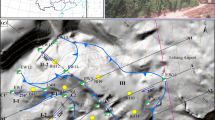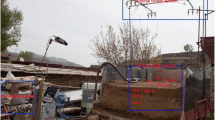Abstract
Slope failure in loess terrains of Northern China during spring thawing period is closely related to the freeze-thaw cycling that surface soils inevitably experienced. Field surveys were carried out on natural and artificial slopes in thirteen surveying sites located in the Northern Shaanxi, the center of Loess Plateau, covering five characteristic topographic features including tablelands, ridges, hills, gullies and valleys. Based on the scale that is involved in freeze-thaw cycling, the induced failures can be classified into three main modes, i.e., erosion, peeling and thaw collapse, depending on both high porosity and loose cementation of loess that is easily affected. Model tests on loess slopes with gradients of 53.1°, 45.0° and 33.7° were carried out to reveal the heat transfer, water migration and deformation during slope failure. The surface morphology of slopes was photographed, with flake shaped erosion and cracks noted. For three slope models, time histories for the thermal regime exhibit three obvious cycles of freeze and thaw and the maximum frost depth develops downwards as freeze-thaw cycling proceeds. Soil water in the unfrozen domain beneath was migrated towards the slope surface, as can be noticed from the considerable change in the unfrozen water content, almost synchronous with the variation of temperature. The displacement in both vertical and horizontal directions varies over time and three obvious cycles can be traced. The residual displacement for each cycle tends to grow and the slopes with higher gradients are more sensitive to potentially sliding during freeze-thaw cycling.
Similar content being viewed by others
References
Cheng XJ, Zhang MS, Zhu LF, et al. (2013) Seasonal freeze-thaw action and its effect on the slope soil strength in Heifangtai area, Gansu Province. Geological Bulletin of China 32 (6): 904–909.
Guo L, Xie YL, Yu QH, et al. (2016) Displacements of tower foundations in permafrost regions along the Qinghai-Tibet power transmission line. Cold Regions Science and Technology 121: 187–195. https://doi.org/10.1016/j.cold regions.2015.07.012.
Harris C, Lewkowicz AG (2000) An analysis of the stability of thawing slopes, Ellesmere island, Nunavut, Canada. Canadian Geotechnical Journal 37: 449–462. https://doi.org/10.1139/cgj-37-2-449.
Harris C, Smith JS, Davies MCR, et al. (2008) An investigation of periglacial slope stability in relation to soil properties based on physical modelling in the geotechnical centrifuge. Geomorphology 93: 437–459. https://doi.org/10.1016/j.geomorph.2007.03.009
Jin HJ, Yu QH, Wang SL, et al. (2008) Changes in permafrost environments along the Qinghai–Tibet engineering corridor induced by anthropogenic activities and climate warming. Cold Regions Science and Technology 53 (3): 317–333. https://doi.org/10.1016/j.coldregions.2007.07.005
Kawamura S, Miura S (2011) Stability evaluation of volcanic slope subjected to rainfall and freeze-thaw action based on field monitoring. Advances in Civil Engineering 2011 (4): 405–415. https://doi.org/10.1155/2011/867909
Kawamura S, Miura S (2013) Rainfall-induced failures of volcanic slopes subjected to freezing and thawing, Soils and Foundations. 53 (3): 443–461. https://doi.org/10.1016/j.sandf. 2013.04.006
Lai YM, Zhang MY, Liu ZQ, et al. (2006) Numerical analysis for cooling effect of open boundary ripped-rock embankment on Qinghai-Tibetan railway. Science in China (Series D: Earth Science) 49 (7): 764–772. https://doi.org/10.1007/s11430- 006-0764-z
Li TL, Li P, Wang H (2013) Forming mechanism of landslides in the seasonal frozen loess region in China, Landslides in cold regions in the context of climate change, part of the series environmental science and engineering. pp 41–51. https://doi.org/10.1007/978-3-319-00867-7_4
Li SY, Lai YM, Zhang MY, et al. (2015) Seasonal differences in seismic responses of embankment on a sloping ground in permafrost regions. Soil Dynamics and Earthquake Engineering 76: 122–135. https://doi.org/10.1016/j.soildyn. 2015.01.005
Li GY, Ma W, Mu YH, et al. (2011) Process and mechanism of freezing and thawing cycle on collapse deformation of compacted loess. China Journal of Highway and Transport 24 (5): 1–5, 10. (In Chinese)
Li GY, Ma W, Mu YH, et al. (2017) Effect of freeze-thaw cycle on engineering properties of loess used as road fills in seasonally frozen ground regions, north China. Journal of Mountain Science 14 (2): 356–368. https://doi.org/10.1007/s11629-016-4005-4
Li L, Zhang K, Zhang Q, et al. (2016) Experimental study on the loess strength degradation characteristics under the action of dry-wet and freeze-thaw cycles. Journal of Glaciology and Geocryology 38 (4): 1142–1149. (In Chinese) https://doi.org/10.7522/j.issn.1000-0240.2016.0133
Liu H, Niu FJ, Niu YH, et al. (2012) Experimental and numerical investigation on temperature characteristics of high-speed railway’s embankment in seasonal frozen regions. Cold Regions Science and Technology 81: 55–64. https://doi.org/10.1016/j.coldregions.2012.04.004
Liu Z, Liu FY, Ma FL, et al. (2016) Collapsibility, composition, and microstructure of loess in China. Canadian Geotechnical Journal 53 (4): 673–686. https://doi.org/10.1139/cgj-2015-0285
Luo XD, Jiang N, Fan XY, et al. (2015) Effects of freeze-thaw on the determination and application of parameters of slope rock mass in cold regions. Cold Regions Science and Technology 110: 32–37. https://doi.org/10.1016/j.coldregions.2014.11.002
Ma W, Qi JL, Wu QB (2008a) Analysis of the deformation of embankments on the Qinghai-Tibet railway. Journal of Geotechnical and Geoenvironmental Engineering 134 (11): 1645–1654. https://doi.org/10.1061/(ASCE)1090-0241(2008)134:11(1645
Ma W, Zhang LX, Wu QB (2008b) Control of asymmetrical subgrade temperature with crushed-rock embankments along the permafrost region of the Qinghai-Tibet railway. Proc. 9th Int. Conf. Permafrost. Institute of Northern Engineering, University of Alaska Fairbanks. pp 1099–1104.
Mao YC, Zhang D, Wu H, et al. (2010) The influence of freezethaw cycles on loess cutting slope in seasonal frozen regions. Proc. 63rd Canadian Geotechnical Conference & 6th Canadian Permafrost Conference. pp 871–877.
McRoberts EC, Morgenstern NR (1974) The stability of thawing slopes. Canadian Geotechnical Journal 11: 447–469. https://doi.org/10.1139/t74-052
Niu FJ, Cheng GD, Xie Q (2002) Study on Instability of slopes in permafrost Regions of Qinghai-Tibet High Plateau. Proc. 5th Int. Symp. Permafrost Engineering, Yakutsk. pp 192–197.
Niu FJ, Cheng GD, Ni WK, et al. (2005) Engineering-related slope failure in permafrost regions of the Qinghai-Tibet Plateau. Cold Regions Science and Technology 42: 215–225. https://doi.org/10.1016/j.coldregions.2005.02.002
Qi JL, Vermeer PA, Cheng GD (2006) A review of the influence of freeze-thaw cycles on soil geotechnical properties. Permafrost and Periglacial Process 17: 245–252. https://doi.org/10.1002/ppp.559
Qin YH, Zhang JM (2010) Estimating the stability of unprotected embankment in warm and ice-rich permafrost region. Cold Regions Science and Technology 61 (1): 65–71. https://doi.org/10.1016/j.coldregions.2009.12.001
Ren CL (2005) The risk assessment and countermeasures of geological hazards in the loess area of Northern Shaanxi. Master’s Thesis for Chang’an University. pp 22–23. (In Chinese)
Shoop SA, Bigl SR (1997) Moisture migration during freeze and thaw of unsaturated soil: modeling and large scale experiment. Cold Region Science and Technology 25: 33–45. https://doi.org/10.1016/S0165-232X (96)00015-8
Ugai K, Leshchinsky D (1995) Three-dimensional limit equilibrium and finite element analysis. Soils and Foundations 2 (4): 1–7. https://doi.org/10.3208/sandf.35.4_1
Wang QF, Zhang TJ, Jin HJ, et al. (2016a) Observational study on the active layer freeze-thaw cycle in the upper reaches of the Heihe River of the north-eastern Qinghai-Tibet Plateau. Quaternary International. https://doi.org/10.1016/j.quaint. 2016.08.027
Wang SH, Qi JL, Yu F, et al. (2013a) A novel method for estimating settlement of embankments in cold regions. Cold Regions Science and Technology 88: 50–58. https://doi.org/10.1016/j.coldregions.2012.12.009
Wang SH, Qi JL, Yu F, et al. (2016b) A novel modeling of settlement of foundations in permafrost regions. Geomechanics and Engineering 10 (2): 225–245. https://doi.org/10.12989/gae.2016.10.2.225
Wu QB, Dong XF, Liu YZ, et al. (2007) Responses of permafrost on the Qinghai-Tibet Plateau to climate change and engineering action. Arctic and Antarctic Alpine Research 39 (4): 682–687. https://doi.org/10.1657/1523-0430 (07-508) [WU]2.0.CO;2
Xu L, Dai FC, Tham LG, et al. (2011) Field testing of irrigation effects on the stability of a cliff edge in loess, north-west China. Engineering Geology 120: 10–17. https://doi.org/10.1016/j.enggeo.2011.03.007
Xu L, Dai FC, Gong QM, et al. (2012) Irrigation-induced loess flow failure in Heifangtai platform, north-west China. Environmental Earth Sciences 66 (6): 1707–1713. https://doi.org/10.1007/s12665-011-0950-y
Xu L, Dai FC, Tu X, et al. (2014) Landslides in a loess platform, north-west China. Landslides 11 (6): 993–1005. https://doi. org/10.1007/s10346-013-0445-x
Xu L, Coop MR (2017) The mechanics of a saturated silty loess with a transitional mode. Geotechnique 67 (7): 581–596. https://doi.org/10.1680/jgeot.16.P.128
Yu F, Qi JL, Yao XL, et al. (2013) Degradation process of permafrost underneath embankments along Qinghai-Tibet Highway: an engineering view. Cold Regions Science and Technology 85: 150–156. https://doi.org/10.1016/j. coldregions.2012.09.001
Yu QH, Cheng GD, Niu FJ (2004) The application of autotemperature- controlled ventilation embankment in Qinghai- Tibet railway. Science in China (Series D: Earth Science) 47 (Supp. I): 168–176. https://doi.org/10.1360/04zd0019
Zhang YD (1996) Wetting induced collapse of loess. Chinese Journal of Geotechnical Engineering 18 (5): 79–83. (In Chinese)
Zhang MS, Li TL (2011) Triggering factors and forming mechanism of loess landslides. Journal of Engineering Geology 19 (4): 530–540. (In Chinese)
Zhang Y, Bing H, Yang C (2015) Influences of freeze-thaw cycles on mechanical properties of silty clay based on SEM and MIP test. Chinse Journal of Rock Mechanics and Engineering 34: 3597–3603. (In Chinese) https://doi.org/10.13722/j.cnki. jrme.2014.0749
Zhang Z, Ma W, Feng WJ, et al. (2016) Reconstruction of soil particle composition during freeze-thaw cycling: a review. Pedosphere 26 (2): 167–179. https://doi.org/10.1016/S1002-0160(15)60033-9
Zhao CL, Shao MA, Jia XX, et al. (2016) Particle size distribution of soils (0-500 cm) in the Loess Plateau, China. Geoderma Regional 7: 251–258. https://doi.org/10.1016/j. geodrs.2016.05.003
Acknowledgements
This research was financially supported by the National Natural Science Foundation of China (Grant Nos. 51478385, 51208409, 51778528 and 51408486). These supports are greatly appreciated. In addition, the authors thank Prof. Long Jin at the State Key Laboratory of Road Engineering Safety and Health in Cold and High-altitude Region, CCCC First Highway Consultants Co., Ltd., Xi’an, China, for his strong support.
Author information
Authors and Affiliations
Corresponding author
Rights and permissions
About this article
Cite this article
Xu, J., Wang, Zq., Ren, Jw. et al. Mechanism of slope failure in loess terrains during spring thawing. J. Mt. Sci. 15, 845–858 (2018). https://doi.org/10.1007/s11629-017-4584-8
Received:
Revised:
Accepted:
Published:
Issue Date:
DOI: https://doi.org/10.1007/s11629-017-4584-8




